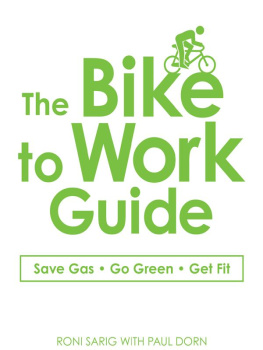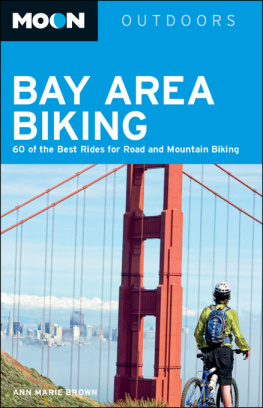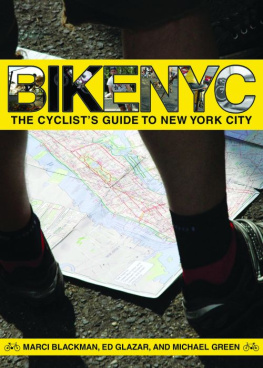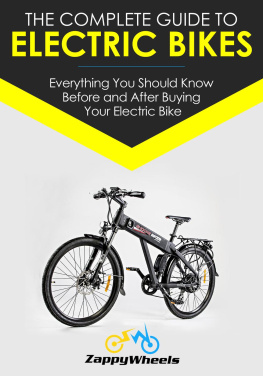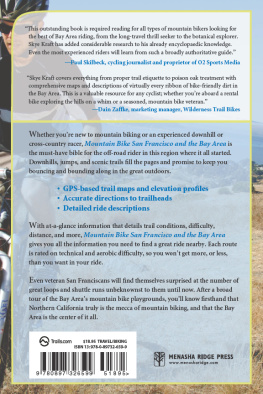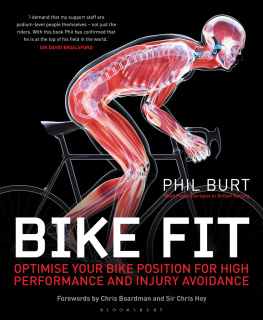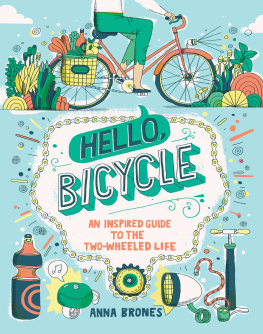

Save Gas Go Green Get Fit
RONI SARIG WITH PAUL DORN

Copyright 2009 by F+W Media, Inc.
All rights reserved. This book, or parts thereof, may not be reproduced in any form without permission from the publisher; exceptions are made for brief excerpts used in published reviews.
ISBN 10: 1-60550-633-8
ISBN 13: 978-1-60550-633-3
eISBN 13: 978-1-6055-0633-3
Published by
Adams Media, an F+W Media Company
57 Littlefield Street, Avon, MA 02322. U.S.A.
www.adamsmedia.com
Contains material adapted and abridged from The Everything Bicycle Book, by Roni Sarig, copyright 1998 by F+W Publications, Inc., ISBN 10:1-55850-706-X, eISBN 13: 978-1-44051-626-9.
Printed in the United States of America.
J I H G F E D C B A
Library of Congress Cataloging-in-Publication Data
is available from the publisher.
This publication is designed to provide accurate and authoritative information with regard to the subject matter covered. It is sold with the understanding that the publisher is not engaged in rendering legal, accounting, or other professional advice. If legal advice or other expert assistance is required, the services of a competent professional person should be sought.
From a Declaration of Principles jointly adopted by
a Committee of the American Bar Association and a
Committee of Publishers and Associations
Many of the designations used by manufacturers and sellers to distinguish their product are claimed as trademarks. Where those designations appear in this book and Adams Media was aware of a trademark claim, the designations have been printed with initial capital letters.
The pages of this book are printed on 100% post-consumer recycled paper.
This book is available at quantity discounts for bulk purchases. For information, please call 1-800-289-0963.
ACKNOWLEDGMENTS
I would like to thank Chelsea King, of Adams Media, for providing the opportunity to develop this book.
I would like to thank the bicyclists of San Francisco, especially those involved with the San Francisco Bicycle Coalition and Critical Mass, for fostering my recovery of bicycling as an adult; the bicycling community of Davis, California, long an inspiration to bicyclists across the United States; and the bicyclists of Sacramento, California, a truly wonderful and underappreciated bicycling city.
I would also like to acknowledge my wife, Marianne Skoczek, always a source of intelligent inspiration.
Paul Dorn
CONTENTS
CHAPTER 1
Why Commute by Bicycle
There are many great reasons to travel to work by bicycle. These include enhanced health, saving the environment, saving money, and saving time. But the greatest appeal of bicycle commuting is simply that its fun. And who couldnt use more fun in their lives?
Does anyone have an enjoyable commute? Certainly not motorists, sitting in parking lots disguised as free ways. Not transit users, crammed into packed buses or trains. Bicycle commuters have fun. From conversations and surveys over many years with bicycle commuters across the United States, we know that joy is a major motivation. People might start commuting by bike to improve their fitness or save money or out of a desire for sustainability, but they persist as bicycle commuters because it is fun.
Ask motorists about their commute, and theyll talk about road rage, a horrific crash they observed, traffic congestion, high gas prices, expensive repairs, parking tickets, and fights with insurance adjusters. Ask transit riders about their commute, and they might talk about missed connections, stale air on the bus or subway, and loud or obnoxious fellow passengers. Ask bicyclists about their commute, and they will smile. And likely mention the endorphin rush, the fresh air, the wildlife they may have seen that morning, a new coffee shop discovery, or how quickly their 401(k) accounts are swelling with money saved not driving.
Bicycle commuting is fun.
HEALTH BENEFITS
The United States confronts a growing public health crisis. The Centers for Disease Control and Prevention (CDC) reports that in the past thirty years, the percentage of overweight and obese adults (aged 2074) has increased to nearly 33 percent. Excessive weight contributes to many diseases and health conditions, including hypertension (high blood pressure), osteoarthritis, type 2 diabetes, coronary heart disease, stroke, and certain cancers.
There are clear physical health benefits of bicycle commuting. The CDC recommends that adults engage in moderate-intensity physical activities for at least thirty minutes at least five days a week. Such activity is easily accomplished by bike commuting everyday.
A less stressful commute also contributes to mental well-being. In recent years, researchers have confirmed the value of regular exercise not only for physical health, but also for reducing anxiety and depression. A four-month research study at Duke University of people suffering from depression found that 60 percent of the participants overcame their depression by exercising for thirty minutes three times a week without antidepressant medicationthe same percentage rate as for those who treated their depression only with medication.
Of course, there are other ways to get exercise. You might join a gym, hire a personal trainer, develop a fitness regimen, install exercise equipment in the basement, and dedicate portions of your week to regular workouts. That works. But is it fun? Some might enjoy riding a stationary bike in a gym. But with pressing work, family, and life obligations, most people eventually lose the motivation to continue with tedious gym activity.
Bicycle commuting improves physical and mental health.
ENVIRONMENTAL BENEFITS
Sustainability is a rapidly emerging priority in the United States. There is increasing awareness and concern about global climate change, international demand for energy, loss of natural habitat to sprawl, health issues related to air quality, challenges with water provision, and destructive agricultural practices.
Policymakers are struggling to find solutions to promote environmental and economic sustainability. Many enlightened politicians, especially at the local level, are embracing bicycling as an important component of an environment-friendly transportation system. In recent years, many cities across the United States have added miles of bike lanes and bike paths, added bike racks to buses and trains, created bike parking facilities, and funded bicycle-safety education programs. This has made bicycle commuting more attractive, and there is evidence that more people are biking. Much more work remains to be done.
Many individuals are also changing their personal consumption habits. They are recycling, replacing incandescent bulbs with energy-efficient compact fluorescents, buying organic foods, using energy-efficient appliances, acquiring fuel-efficient cars, and installing solar panels. But are any of these necessary activities fun?
The bicycle is the most energy-efficient personal transportation device ever created. Bicycle commuting is sustainable and fun.
ECONOMIC BENEFITS
Life has gotten expensive. Housing, food, movies, health care, and college tuition are all more expensive. Retirement is more challenging. And gas prices have risen significantly. While many debate peak oilthe idea that the world has already used half of all oil, meaning a future of diminishing fuel suppliesthe days of $3-a-gallon gas are far, far behind.
Next page
